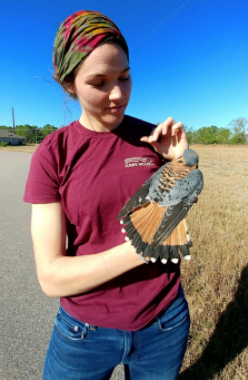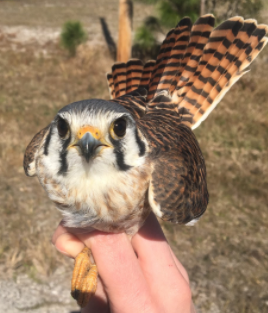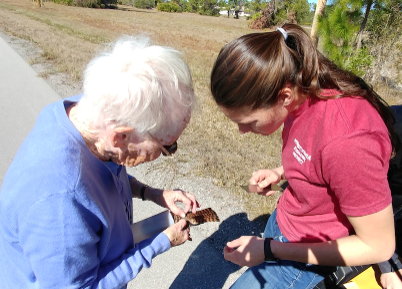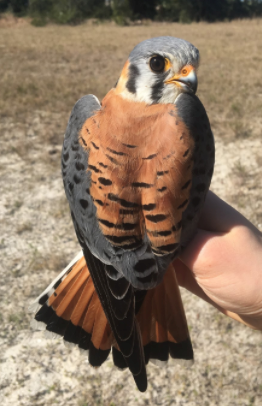Cape Coral Kestrels
Posted on in In the Field by Kirsten Fuller, Spring 2018 Conservation Science Trainee

Over the last year I transitioned from my familiar world of science education and immersed myself in the exciting field of raptor research! In January, I was lucky to have the opportunity to travel to Cape Coral, Florida to learn about American kestrels with Hawk Mountain research biologist Laurie Goodrich, and long-term kestrel researcher Sue Robertson.
Sue and her husband Bob first noticed the abundance of American kestrels wintering in Cape Coral in the late 1980’s. They began trapping and banding the birds, and nearly 30 years later the data is still being collected.
These small falcons prefer open fields with low grass, which makes it easier for them to spot their prey. In the winter, these birds have plenty of insects to eat in Florida, but they also find small rodents appealing. This was our bait of choice. We searched for kestrels as we drove around the northern part of the peninsula, which is less developed than the southern part. When a bird was spotted, we would toss the trap out the door of the car, taking care to do this quickly and stealthily. It was then a waiting game for the bird to abandon its perch and land on the trap.

Once we had a bird trapped, we moved quickly to release it and begin the banding process, during which Sue taught me how to measure the length of the tail feathers and the wing chord. The majority of birds we trapped were male, which was interesting because 30 years ago Sue found that the majority of the small falcons in the same area of Cape Coral were female. In the past, this may have been attributed to females migrating earlier than males and therefore staking a claim on the available optimal habitat. A more equal distribution of male and female kestrels in the optimal habitat in Cape Coral, as we observed, may be a reflection of the declining trend in American kestrels that scientists are seeing nationwide.
Over the past 30 years, the available kestrel habitat of Cape Coral has changed quite a bit. What was once a habitat perfectly maintained for kestrels, with mowed plots of land and plenty of telephone wires for perching (foreshadowing the impending land development), there are now rows of homes and less undisturbed open habitat.

It was an invaluable experience to learn from knowledgeable and passionate conservation researchers, Laurie and Sue. Plus, it wasn’t so bad to hang out in Florida for a few days in January, and I got to catch a glimpse at a Burrowing Owl! I am back at Hawk Mountain now, and I am so thrilled to see American kestrels buzzing around farmlands near the Mountain, preparing for nesting season. Check out the Hawk Mountain kestrel nestbox cam at www.hawkmountain.org/kestrelcam, and learn more about our farmland raptor conservation efforts at www.hawkmountain.org/farmlandraptors.
